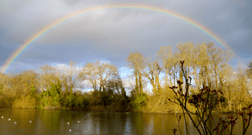At the end of February, the skies were beginning to clear from a rain filled winter and river levels across the UK were returning to normal levels after major flooding. The Thames was beginning to show signs of Spring with buds appearing on trees and wildlife looking for mates to begin the nesting period. In the background, news of a deadly virus was hitting the airways. Little did we know what the sign of a rainbow was to represent over the coming months.

The UK Government began public discussions of the virus, which had spread to Europe and fears of bigger problems became apparent. Meanwhile, the Thames was now back to normal flow levels and its inhabitants were getting busy finding their nesting materials and choosing their locations to lay their eggs. As the virus began to show itself in the UK, we were starting the stages we now know to be social distancing. From 23rd March, we were told to stay at home. This included only leaving home for food and 1 hour of exercise per day. Soon to follow was notification from the Environmental Agency that locks would be on self-service and only essential travel was allowed, with boating not to be considered essential travel. An eeriness fell over the river world with only the sounds of birds chirping in the air.
Meanwhile, on the Thames, work was well underway for nesting and love was all around. Newly paired ducks, coots, moorhens, geese, grebes and swans were setting up home in hope that their eggs will hatch. Those who choose their exercise in a personal kayak noticed the ever-growing nests with inhabitants soon to become parents.

With only essential boat traffic, nests were more able to survive through the laying and incubation process. The Inland Waterways Advisory Council states in their publication ‘Balancing the need of navigation and the aquatic wildlife,’ “The effects on birds and mammals from boat traffic are associated with the loss of vegetation. At moderate levels, progressive loss of submerged plants and consequential loss of invertebrates and fish reduces food availability for species such as coot, grebe, heron and kingfishers.” Personal motorboats can reach high speeds, creating large wakes and often getting too close to the shorelines disturbing nest, knocking eggs out and even flooding nests.

Although many of the rivers and waterways in the UK are shared by wildlife and humans, levels of wildlife have dropped in recent years due to the sheer amount of boat traffic, and excess speed. Nearly all the rivers and canals in the UK are used for pleasure, and we need to have an awareness of the impact we create on nature through our desire to use the waterways with motorised boats. Although the virus has been devasting to many of us, there has been a noticeable increase in hatched wildlife that has survived due to the lockdown on our rivers. Now that an easing in lockdown measures has begun, this experience gives us a chance to re-evaluate what is important and how we want to live going forward. By maintaining lower levels of speed and limiting trips using motors, we can ensure birds and mammals that inhabit our rivers and canals a safe breeding place for years to come.


